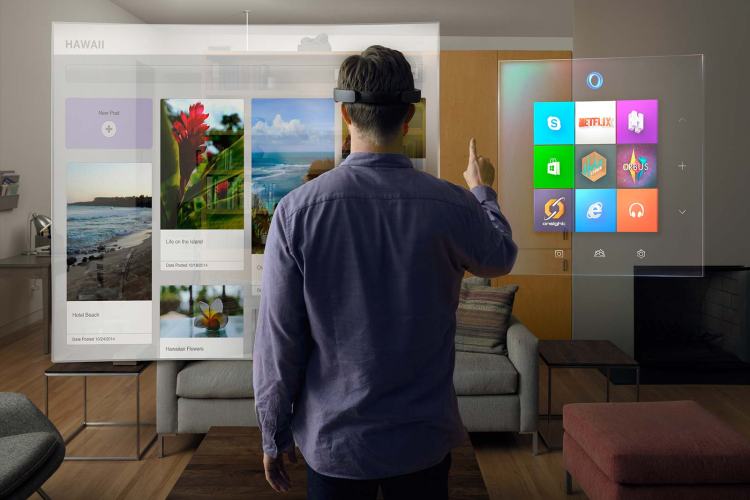Over Independence Day weekend, I got a chance to finally check out a futuristic headset produced by Microsoft called the HoloLens.

There are three emerging types of digital reality:
- Virtual Reality (VR) completely blocks your reality and replaces it with something completely different (think Oculus Rift).
- Mixed Reality (MR) inserts new things to your current reality (like the HoloLens).
- Augmented Reality (AR) adds helpful information to your current reality (think Google Glass).
Technically speaking, the HoloLens is a mixed-reality head-mounted pair of smartglasses. In plain English, the HoloLens blends your actual surroundings with simulated images to create a brand new reality inside a familiar space.
For instance, I played two games that transformed my living room into two very different scenarios. In the first game, RoboRaid, aliens were breaking down my walls to attack me – here’s a video of what it was like. In the second game, Fragments, I was a detective investigating a crime scene and I even had my boss (in the game) sitting on my couch during a meeting – here’s a video of what it was like.
Though games are fun, often games are created for a new platform – like the HoloLens – less for actually producing a game that a wide-audience will play and more for exploring the possibilities of a new technology.
All of that got me thinking…
What possibilities could technologies like the HoloLens offer the church in the future?
Four Possible Uses for Digital Reality in Churches
Right now, digital reality is still in its infancy. The lack of development, the expense of the technology, and the bandwidth needed all still limit its reach. But, dreaming of tomorrow, what might the future hold?
- More life-like worship experiences at home. Today as people tune into church online, they watch the digital stream that is going to the projectors. What if VR was captured from the fifth row of the worship center and viewers could look around and see the stage, the projection, and even other worshipers?
- People could experience location-based events remotely. If you’ve ever come back from a trip overseas you’ve tried to explain what it was like – but no one really gets it because they weren’t there. What if they could be? What if you could experience a third-world country, a summer camp atmosphere, or a baptism service in another state through VR?
- Children could actually experience the events of Scripture. We’ve come a long way since felt boards, but the purpose is still the same: we want kids to really understand the events of the Scripture. What if they could see the rain falling from the Flood, Jesus walking on the water, or the angel announcing the Resurrection through the use of VR?
- Digital small groups. This one is my favorite. Though the goal of small groups is to get people to live life together, what if they could do this remotely through MR? Just because you can’t touch them – but you can see them sitting on your couch (like in the game I talked about earlier) – does that make these future small groups less effective?
So, what do you think?
Does digital reality have a future in the church?
What uses can you dream up? Let me know!